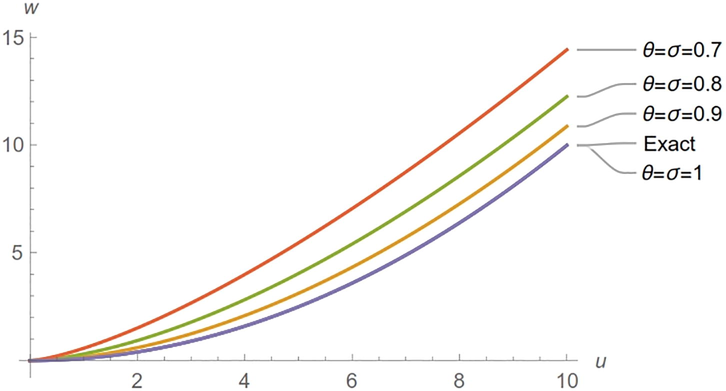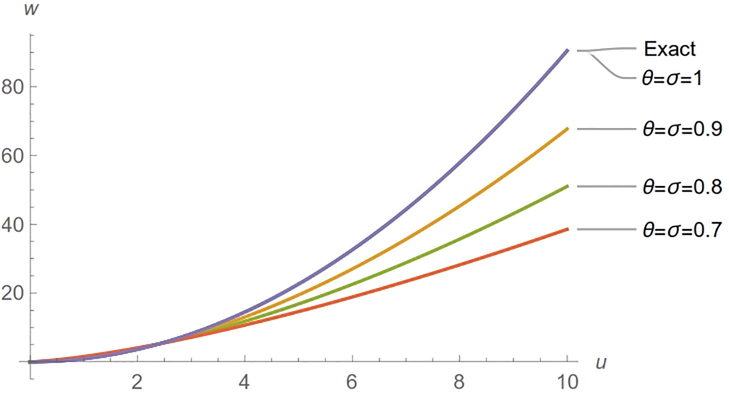Translate this page into:
Modified Double Conformable Laplace Transform and Singular Fractional Pseudo-Hyperbolic and Pseudo-Parabolic Equations
⁎Corresponding author. tarig.alzaki@gmail.com (Tarig M. Elzaki),
-
Received: ,
Accepted: ,
This article was originally published by Elsevier and was migrated to Scientific Scholar after the change of Publisher.
Peer review under responsibility of King Saud University.
Abstract
In this paper, double conformable Laplace’s transform (DCLT) and a few of its properties were studied, and then combine it with a new method to solve a new type of fractional partial differential equations called “Singular Fractional Pseudo-hyperbolic and Pseudo-parabolic Equations”. We observe that this method is extremely efficient to these equations because we have created an exact solution by taking just one step at the same time as the other methods need more steps to get the exact solution.
Keywords
Double conformable Laplace’s Transform (DCLT)
Singular Fractional Pseudo-Hyperbolic Equation
Singular Fractional Pseudo-Parabolic Equation
1 Introduction
Subject area of (DCLTs) and its attributes are still fresh, some properties and definitions of fractional calculus were also considered in Abdeljawad (2015), Alderremy et al. (2018), Atangana et al. (2015), and Baleanu et al. (2019), Some fractional partial differential equations were also solved (Gadain, 2017; Khalil et al., 2014), many researchers have given their attention to examining the solutions of fractional linear and nonlinear PDEs by different methods (Mustafa Inc et al., 2018, 2019; Aliyu, et al., 2019). Along with these attacks are the Elzaki transform (Elzaki, 2014; Elzaki and Eman, 2012; Elzaki and Alderremy, 2018), Homotopy perturbation method (Mohamed and Elzaki, 2020), Laplace transforms (Korkmaz, 2018), and double Laplace transform (Elzaki 2012) (Fig. 1).
Exact and approximate solutions for Example1.
In this theme, we will inaugurate a novel double conformable Laplace's transform and a few of its attributes and mix this transform with the new method to figure out the singular fractional Pseudo-hyperbolic and Pseudo-parabolic equations. The robustness and the effectiveness of the proposed method lies in the fact that it found the exact solution by taking only one approximation, while the other methods take a several of approximations (Fig. 2).
Exact and approximate solutions for Example 2.
We think that the double conformable Laplace's transform technique is expanded in the near future to solve a real model problem that related to Fractional Pseudo-hyperbolic or Pseudo-parabolic equations in science and engineering such heat and mass transfer problem (Emmanuel et al., 2018), fluid flow problem, quantum mechanics, (Aliyu et al., 2019) etc.
If is a function of then the conformable fractional derivative (CFD) with respect to then, th order (CFD)is defined by:
If is the th order (CFD) with respect to then,
If is a function of two variables then:
-
the conformable single Laplace transform (CSLT) with respect to designated by the operator , is defined by:
(ii) the (CSLT) with respect to
of
, is,
(iii) The conformable double Laplace’s transform (CDLT) of, is,
Note that:
If , is a function of two variables, then the (CDLT) of fractional partial derivatives are,
Also, we see the (CDLT) of the following functions,
For proof and more details, see [3,13].
2 Method of solution
To explicate the method of solution, we will think about the following fractional PDE,
With the initial conditions,
for a fractional Pseudo-parabolic equation, and for a fractional Pseudo-hyperbolic equation, In this general study, we put is the th, order conformable fractional partial derivative of . and, are a linear operator and a nonlinear operator respectively.
To, obtain the result of the Eqs. (6), (7), we get hold of the (CDLT) of Eq.(6), and (CSLT) of Eq. (7), to obtain,
And,
Let:
is the a solution of Eq. (6).
After substituting Eq. (9), in Eq. (8), taking the conformable inverse of (DLT) of Eq. (8), to obtain,
In lodge to obtain the exact solution by selecting only one measure, we must prefer the best initial iteration
if we choose,
then, the recursive relation is,
3 Application
To demonstrate the productivity of this technique in solves the singular fractional Pseudo-hyperbolic and singular fractional Pseudo-parabolic equations, by accepting just one step, we establish the previous examples.
Consider the singular fractional Pseudo-parabolic equation,
with,
Practicing the same steps mentioned as before to obtain,
By definition 1.4 and the initial condition (13), Eq. (14) becomes,
Getting hold of the conformable inverse of (DLT) of Eq. (15), to obtain,
Then the recursive relation is,
The first few components are given by,
If we use Eq. (10), then the solution of the Eq. (12) is,
We can see if then the exact solution is, , is bounded.
Consider the singular Pseudo-hyperbolic equation,
With,
Using the same steps which we used in example 1, to prevail;
Getting hold of the conformable inverse of (DLT) of the last equation to make,
Thus, we be able to write down the recursive relations as,
And so the first few components are,
Then, the solution of Eq. (17) is,
If then, the exact solution is, is bounded.
4 Conclusion
The (CDLT) and a few of its properties were studied, also we study the (CDLT) of fractional derivatives and few functions, and then we combine (CDLT) with a new method to solve a new type of fractional partial differential equations called “Singular Fractional Pseudo-hyperbolic and Pseudo-parabolic Equations”. This method is extremely easy and useful to solve these fractional differential equations which are related with the engineering and physical sciences because we get the exact solution by taking just one step compared with other methods that require several steps to get the exact solution.
We will look at possibility of tackle fractional Pseudo- elliptic Equations using this method in the future study.
Acknowledgment
The authors extend their appreciation to the Deanship of Scientific Research at King Khalid University for funding this work through the General Research Project under grant number (G.R.P-167-40).
Declaration of Competing Interest
The authors declare that they have no known competing financial interests or personal relationships that could have appeared to influence the work reported in this paper.
References
- Dynamics of optical solitons, multipliers and conservation laws to the nonlinear schrödinger equation in (2+1)-dimensions with non-Kerr law nonlinearity. J. Mod. Opt.. 2019;66(2):136-142.
- [CrossRef] [Google Scholar]
- New transform iterative method for solving some Klein-Gordon equations. Results Phys.. 2018;10:655-659.
- [CrossRef] [Google Scholar]
- Dumitru Baleanu, Mustafa Inc, Aliyu Isa Aliyu & Abdullahi Yusuf (2019) The investigation of soliton solutions and conservation laws to the coupled generalized Schrödinger–Boussinesq system, Waves in Random and Complex Media, 29:1, 77- .92, DOI: 10.1080/17455030.2017.1412539.
- Jesús Emmanuel, Solís Pérez, José Francisco Gómez-Aguilar, Dumitru Baleanuand Fairouz Tchier, 2018. Chaotic attractors with fractional conformable derivatives in the Liouville-Caputo sense and its dynamical behaviors. Entropy, 20 (5), 384.
- Application of double Laplace decomposition method for solving singular one dimensional system of hyperbolic equations. J. Nonlinear Sci. Appl.. 2017;10:111-121.
- [Google Scholar]
- On the wave solutions of conformable fractional evolution equations. Commun. Fac. Sci. Univ. Ank. Ser. A1. 2018;67(1):68-79.
- [Google Scholar]
- Mohamed Z. Mohamed, Tarig M. Elzaki, 2020. Applications of new integral transform for linear and nonlinear fractional partial differential equations, Journal of King Saud University – Science, 32, 544–549. https://doi.org/10.1016/j.jksus.2018.08.003.
- Mustafa Inc , Hamdy I. Abdel Gawad, Mohammad Tantawy, Abdullahi Yusuf, 2019. On multiple soliton similariton‐pair solutions, conservation laws via multiplier and stability analysis for the Whitham–Broer–Kaup equations in weakly dispersive media, Mathem. Methods Appl. Sci., 42(7), (2019) 2455–2464.
- Mustafa Inc, Aliyu Isa Aliyu, Abdullahi Yusuf, Dumitru Baleanu, (2018), Novel optical solitary waves and modulation instability analysis for the coupled nonlinear Schrödinger equation in monomode step-index optical fibers, Superlatt. Microstruct. 113 (2018) 745–753.
- On the new double integral transform for solving singular system of hyperbolic equations. J. Nonlinear Sci. Appl.. 2018;11:1207-1214. Available online at www.isr-publications.com/jnsa
- [Google Scholar]
- Application of projected differential transform method on nonlinear partial differential equations with proportional delay in one variable. World Appl. Sci. J.. 2014;30(3):345-349.
- [CrossRef] [Google Scholar]
- Tarig M. Elzaki, 2012. Double laplace variational iteration method for solution of nonlinear convolution partial differential equations, Archives Des Sciences, ISSN 1661-464X, Vol. 65, No. 12, PP. 588–593.
- Tarig M. Elzaki, Eman M.A. Hilal, 2012. Solution of Telegraph Equation by Modified of Double Sumudu Transform “Elzaki Transform” , Mathematical Theory and Modeling, ISSN 2224-5804 (Paper) ISSN 2225-0522 (Online), Vol.2, No.4, pp, 95-103.







